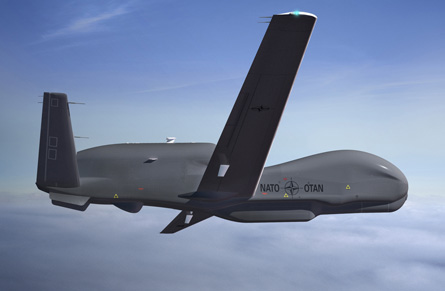An international team led by Northrop Grumman will submit its final proposal for the NATO Alliance Ground Surveillance (AGS) programme this week, with its solution based on the proven RQ-4 Global Hawk unmanned air vehicle.
Fifteen NATO and Partnership for Peace nations signed a programme memorandum of understanding for the long-planned AGS capability last September, clearing the way for the agency to establish two management bodies to acquire and operate the equipment.
Northrop and its industry partners have finalised their core system offering, with this involving more than 25 companies from all 15 nations, says Bob Zeiser, its NATO AGS business development director.
 |
|---|
© Northrop Grumman |
Lead partners on the estimated €1.5 billion ($1.8 billion) programme include EADS Deutschland, GD Canada and Italy's Selex Galileo, with these to provide key equipment such as the system's ground segment.
"We have found what we think is the optimum balance between affordability, execution of the programme and participation," says Zeiser. With affordability a "significant challenge", Zeiser hints that the proposal could include a pledge to sustain NATO's two required surveillance orbits using fewer UAVs than previously planned.
NATO's earlier assumptions outlined a fleet of eight modified Block 40 RQ-4B Global Hawk high-altitude, long-endurance unmanned air vehicles, to be based at Sigonella in Sicily. Each will carry a Northrop/Raytheon multi-platform radar technology insertion programme payload, which will deliver synthetic aperture radar and ground moving target indication data.
"The original premise of eight was based on a very conservative estimate on expected Global Hawk performance," Zeiser says. "To perform the missions outlined, you would not need as many, and I think that will be well received."
Negotiations are expected to run through the summer, with both parties hoping to agree a contract in time for the NATO Summit in Lisbon in October.
Meanwhile, Zeiser says he is "fully optimistic" that additional countries will join the core AGS programme. "The top five nations are providing about 90% of the funding, so it's not very costly for a nation to join and get the benefit of receiving the data," he says.
Northrop expects the AGS capability to achieve initial operational capability around 2015, by using off-the-shelf systems where possible. "This is the shortest production phase we have had through the course of the programme," says Zeiser. "The warfighter wanted this capability yesterday. This way we can buy back some of that time."
Source: Flight Daily News



















